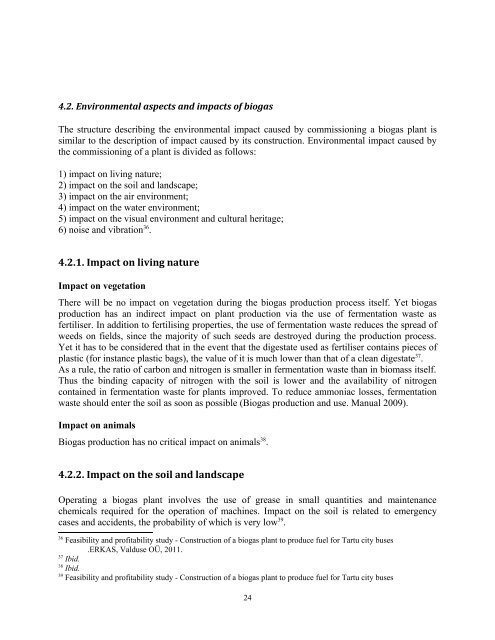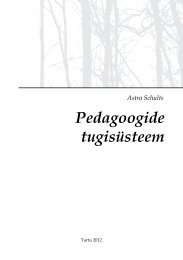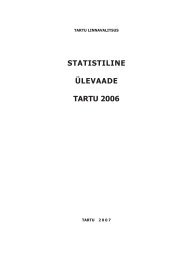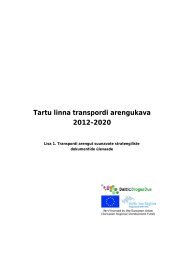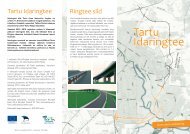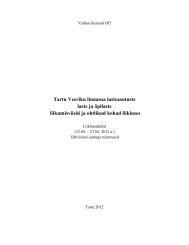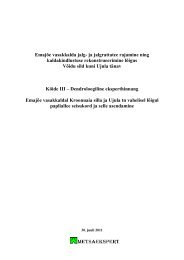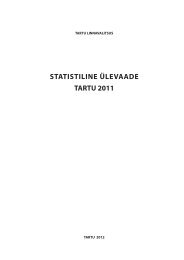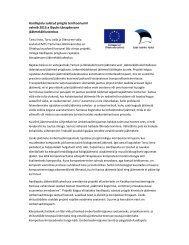Regional Biogas Development Strategy and Action Plan - Tartu
Regional Biogas Development Strategy and Action Plan - Tartu
Regional Biogas Development Strategy and Action Plan - Tartu
You also want an ePaper? Increase the reach of your titles
YUMPU automatically turns print PDFs into web optimized ePapers that Google loves.
4.2. Environmental aspects <strong>and</strong> impacts of biogas<br />
The structure describing the environmental impact caused by commissioning a biogas plant is<br />
similar to the description of impact caused by its construction. Environmental impact caused by<br />
the commissioning of a plant is divided as follows:<br />
1) impact on living nature;<br />
2) impact on the soil <strong>and</strong> l<strong>and</strong>scape;<br />
3) impact on the air environment;<br />
4) impact on the water environment;<br />
5) impact on the visual environment <strong>and</strong> cultural heritage;<br />
6) noise <strong>and</strong> vibration 36 .<br />
4.2.1. Impact on living nature<br />
Impact on vegetation<br />
There will be no impact on vegetation during the biogas production process itself. Yet biogas<br />
production has an indirect impact on plant production via the use of fermentation waste as<br />
fertiliser. In addition to fertilising properties, the use of fermentation waste reduces the spread of<br />
weeds on fields, since the majority of such seeds are destroyed during the production process.<br />
Yet it has to be considered that in the event that the digestate used as fertiliser contains pieces of<br />
plastic (for instance plastic bags), the value of it is much lower than that of a clean digestate 37 .<br />
As a rule, the ratio of carbon <strong>and</strong> nitrogen is smaller in fermentation waste than in biomass itself.<br />
Thus the binding capacity of nitrogen with the soil is lower <strong>and</strong> the availability of nitrogen<br />
contained in fermentation waste for plants improved. To reduce ammoniac losses, fermentation<br />
waste should enter the soil as soon as possible (<strong>Biogas</strong> production <strong>and</strong> use. Manual 2009).<br />
Impact on animals<br />
<strong>Biogas</strong> production has no critical impact on animals 38 .<br />
4.2.2. Impact on the soil <strong>and</strong> l<strong>and</strong>scape<br />
Operating a biogas plant involves the use of grease in small quantities <strong>and</strong> maintenance<br />
chemicals required for the operation of machines. Impact on the soil is related to emergency<br />
cases <strong>and</strong> accidents, the probability of which is very low 39 .<br />
36<br />
Feasibility <strong>and</strong> profitability study - Construction of a biogas plant to produce fuel for <strong>Tartu</strong> city buses<br />
.ERKAS, Valduse OÜ, 2011.<br />
37<br />
Ibid.<br />
38<br />
Ibid.<br />
39<br />
Feasibility <strong>and</strong> profitability study - Construction of a biogas plant to produce fuel for <strong>Tartu</strong> city buses<br />
24


